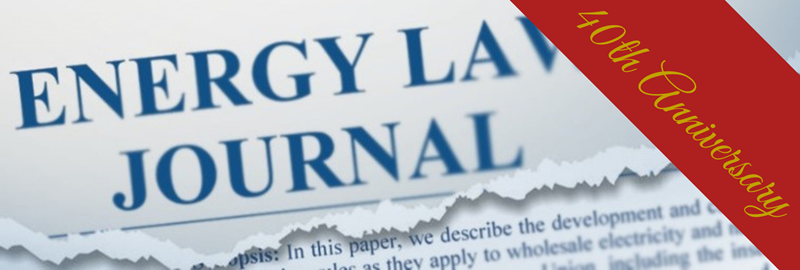
The Energy Law Journal Celebrated its 40th Anniversary in 2020
Published by The Energy Bar Association and University of Tulsa College of Law
The Energy Law Journal was first published in May 1980 and now reaches thousands of readers in the United States and 10 foreign countries, including Canada, England, Brazil, Argentina, Germany, Austria, France, Italy, Spain, Switzerland, Scotland, Singapore, Nigeria, Greece, and Turkey. The Journal has become a preeminent energy publication, providing thought-provoking and deeply researched articles by practitioners, internationally known academics, Federal judges, high ranking government officials and members of FERC. The Journal often has been cited by Federal and State Courts and agencies, law review articles and journals, energy industry speakers and the FERC. The Journal maintains a list of court opinions and other published legal materials citing articles appearing in the Journal.
See the Current Edition See Past Editions
Writing for the Journal
The Energy Law Journal publishes legal, policy, and economic articles and other materials of lasting interest with significant research value on subjects dealing with the energy industries. The Journal welcomes articles and other materials on emerging issues and significant developments affecting the energy industries. The Journal publishes articles and other materials of varying length that provide a full consideration of the issues and opposing viewpoints.
All manuscripts must contain a synopsis, table of contents, and brief biographical statement about the author(s). Style and form of citations must be in conformity with the "Blue Book," as well as the Energy Law Journal Style Manual.
Editorial Review
The Journal's peer review process differs significantly from student-run law journals. The Editor-in-Chief (in consultation with the Executive Editor and the ELJ's peer review editors), not the students editors, decides what gets published. Among the factors the Editor-in-Chief will consider are the article's lasting value to practitioners, regulators and policy makers, whether the article contains a comprehensive analysis of the issue(s), and the quality of writing. When an author submits an article for consideration, the Editor-in-Chief and the Executive Editor will conduct an initial review. They may then request the prospective author(s) to discuss the draft article and these editors' comments and suggestions. After the author has submitted a revised draft, the Editor-in-Chief and the Executive Editor will consult with the editorial board members – the ELJ's peer review editors – to assign the draft article to a peer review editor for further, more detailed review. The author(s) will then be given an opportunity to make additional edits and revisions to the draft to respond to the peer review editor's comments and suggestions.
The ELJ's editorial board members are selected by the Editor-in-Chief, and are chosen to serve based on their writing and editing experience and in conformity with the EBA's diversity, equity and inclusion guidelines. Only after peer review does the article go to the student editors and the University of Tulsa College of Law. The student editors are not tasked with making substantive edits, but rather review the draft article for grammar and structure, to cite check and to conduct a review for possible plagiarism. Authors are then given the opportunity to proofread the draft and to make any final additions or corrections.
The Journal also includes committee reports covering substantive and procedural developments in various areas of energy law. These, like the articles, are also peer-reviewed by the Journal's committee reports editors. Unlike articles, however, the reports do not include opinions, but simply recount developments, including holdings in relevant cases and the contents of new agency rules, policy statements, etc.
Last, the Journal also accepts for publication certain student notes submitted by the student editors of the Journal. These student notes are edited by practitioner editors of the Journal. Because the Journal is a peer-reviewed publication, we do not accept proposed articles solely-authored by law students.
Submission Process
All manuscripts should be sent to HARVEY L. REITER, EDITOR-IN-CHIEF. New editions of the Journal are published in mid-May and again in mid-November. Authors should submit a detailed outline or full draft approximately six months before the scheduled publication date to have an article considered for publication in a specific edition, i.e, by late May for publication in the November edition and by late November for publication in the following year's May edition. The Journal will make occasional exceptions to this deadline on a case-by-case basis.
A full digital version of the Journal is free to all members of the Energy Bar Association. Subscriptions to the hard copies of the Journal for EBA members are $35.00 per year. Non-members please see subscription information at: Journal Subscriptions. Back issues are available by contacting the William S. Hein & Co. at (800) 828-7571.
Copyright
The Energy Bar Association holds the copyright to written works published in the Energy Law Journal. The Energy Bar Association grants permission to authors of written works published in the Journal to reproduce and distribute their written works provided that: (1) copies are distributed at or below cost; (2) proper notice of copyright is included on each copy; and (3) the Energy Law Journal and the article author(s) are clearly identified on each copy. Authors are also permitted either to provide a website link to their articles on the Energy Bar Association website or to post copies of the articles they have written on their own or their organization’s website, provided that the posted article clearly identifies the Energy Law Journal. For reprint permission, email admin@eba-net.org.
